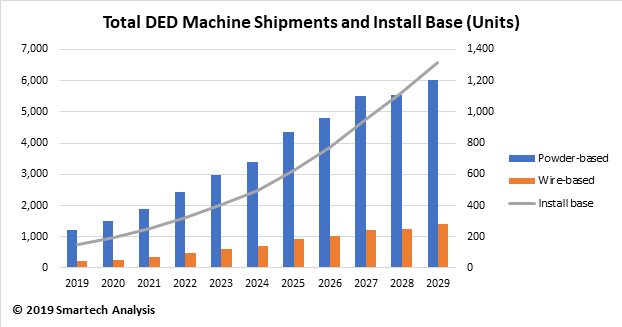In 2012, the story went that low cost 3D printers (at the time most were calling these “consumer 3D printers”) would become the next consumer electronic hit, infiltrating homes at first in the developed world and later worldwide, creating a societal revolution with people making things they wanted or needed rather than purchasing them.
Low Cost Printing: The Truth
Today, the perception — shared by the majority of the media and stakeholders in the 3D printing industry – has gone through a 180 degree shift. Low cost 3D printers are supposedly doomed to remain a gimmicky plastic widget machine that few will find use for. And because consumers don’t know what to do with them, low cost 3D printers are already passé, while professional- and production-grade 3D printing races ahead.
We at SmarTech believe that this newer take on the status of low-cost 3D printing is just as wrong as the earlier one. The current story being told about low-cost 3DP, it seems to us, shares the same shortsighted, emotion driven pitfalls of the popular perception four years ago held.
We think that not only are low cost 3D printers here to stay, but those who do not embrace this reality within the 3D printing industry are likely to regret it.
To show where the low cost 3D printing market is really headed, SmarTech has recently compiled the most in-depth market analysis and forecast for the low cost 3D printing segment currently available. More details and a full table of contents for this report – Opportunities in Low-Cost 3D Printers: Technologies, Materials and Markets – 2016 — can be found at https://additivemanufacturingresearch.com/reports/opportunities-in-low-cost-3d-printers-technologies-materials-and-markets-2016/
In this report, we present the truth about low cost 3D printing in a time when a number of influential opinions on the segment have soured.
Why the Low Cost 3D Printer Market will Thrive
The bottom line is that SmarTech believes that the low cost 3D printer market will become the multi-billion dollar market that was once predicted for it, but not by taking the same path as the CD player and iPhone. Instead, we will see low cost printers taking a
novel three-tiered approach based on bringing value to customers.
Life-style customization: 3D printing isn’t right for everyone –or even most people. But it is a massively valuable tool for that segment of the populace that are both highly creative and enthusiasts in particular lifestyles.
This may sound like the “maker” movement redux. But we think that what we are talking about here is a lot bigger than that and is best characterized as life-style customization. We see this as a more specific version of the mass customization that was talked about a few years back. SmarTech’s view is that this is what the “real” 3D printing revolution will consist of.
Approaching consumer 3D printers as a tool for customizing a lifestyle is how to sell tens of thousands of printers to those people already invest in activities where 3DP can take that lifestyle to a level not possible in any other way.
PC-like market expansion through low cost 3DP: Although this was not the intent of the first wave of low cost 3D printer makers, what SmarTech is seeing is a massive upswing in professional customers purchasing low cost printer for distributed prototyping and innovative manufacturing solutions. For example, Siemens uses Ultimaker 3D printers to cast metal parts with a 3D-printed indirect manufacturing solution.
In much the same way the personal computers broadened the addressable market for computing by orders of magnitude, we see 3D printers doing something similar in the manufacturing sector. In other words low cost 3D will bring the benefits of flexible, reduced capital production and lead time reduction to a whole new wave of entrepreneurs and R&D teams that will create new business models predicated on additive manufacturing.
Innovative manufacturing solutions: While the first two factors mentioned above are relatively deterministic and predictable, we also think that the availability of powerful low cost additive manufacturing tools will inspire entirely new applications; ones we have not thought of yet. Again, this was something that occurred during the “PC revolution.”
Indeed, low cost printers have already shown what is possible through embracing innovation and collaboration in this field. No better example exists here than what can be seen in the market for low cost material extrusion print materials. For over a decade, the only material extrusion materials were a relatively narrow subset of engineering thermoplastics based around ABS, nylons, and polycarbonate.
Today, thanks to the low cost printing segment, it has been proven that material extrusion technology can be the ticket to printing flexible, aesthetically filled, and extremely strong parts. And users of professional 3D printers have taken notice.
OEMs Must Adjust to New Circumstances
None of this is to say that several of the first mover OEMs in the low cost printer world weren’t without blame for the dark cloud that has come over this segment of the 3DP market. In early 2014 I wrote about how MakerBot’s strategic direction was missing the mark and potentially heading for a fall.
Of course, 3D Systems’ decision to back off its “consumer”3D printing initiatives did a lot to convince those not paying very close attention that low cost 3D printing was a fairytale. Ultimately, we think that the company’s fear of cannibalizing sales for its professional products likely put the brakes on releasing its most potentially disruptive low cost printing products that have been in development for years.
But if low cost printing was in trouble as evidenced by 3D Systems and MakerBot faltering due to poor strategic, nobody told the likes of Ultimaker, Aleph Objects, Type A Machines, XYZPrinting, Zortrax, and many more, who have capitalizing on the desires of the market to massive year over year success.
In fact, as SmarTech sees it the mass of leaders vying for control of the low cost segment in today’s market have proven that low cost printing is here to stay, whether those not paying close enough attention care to acknowledge it or not.
Clearly, low cost printers are a segment to watch in the next five years. The road to growth may not be as easy or quick as most thought three years ago, but it certainly exists, perhaps even stronger than before when approached the proper understanding and strategies.




